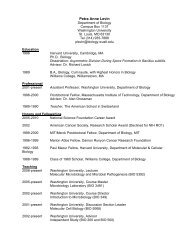Basic Format for the Plant Biology Qualifying Exam Research ...
Basic Format for the Plant Biology Qualifying Exam Research ...
Basic Format for the Plant Biology Qualifying Exam Research ...
You also want an ePaper? Increase the reach of your titles
YUMPU automatically turns print PDFs into web optimized ePapers that Google loves.
<strong>Basic</strong> <strong>Format</strong> <strong>for</strong> <strong>the</strong> <strong>Plant</strong> <strong>Biology</strong> <strong>Qualifying</strong> <strong>Exam</strong> <strong>Research</strong> ProposalExcerpts from <strong>the</strong> instructions <strong>for</strong> <strong>the</strong> Individual National <strong>Research</strong> Service Award(NRSA) proposal at: http://grants.nih.gov/grants/funding/416/phs416.htmCompiled by Erica Fishel1. IntroductionAll resubmission applications must include an Introduction of no more than one pagethat summarizes <strong>the</strong> substantial additions, deletions, and changes. The Introductionmust also include responses to criticisms and issues raised in <strong>the</strong> summary statement<strong>for</strong> <strong>the</strong> previous application. Insert <strong>the</strong> Introduction just be<strong>for</strong>e <strong>the</strong> very beginning of <strong>the</strong><strong>Research</strong> Training Plan. Application processing may be delayed or <strong>the</strong> application maybe returned if it does not comply with all of <strong>the</strong>se requirements.2. Specific AimsList <strong>the</strong> broad, long-term objectives and <strong>the</strong> goal of <strong>the</strong> specific research proposed, e.g.,to test a stated hypo<strong>the</strong>sis, create a novel design, solve a specific problem, challengean existing paradigm or clinical practice, address a critical barrier to progress in <strong>the</strong>field, or develop new technology.3. Background and SignificanceBriefly sketch <strong>the</strong> background leading to <strong>the</strong> present application, critically evaluateexisting knowledge, and specifically identify <strong>the</strong> gaps that <strong>the</strong> project is intended to fill.State concisely <strong>the</strong> importance and health relevance of <strong>the</strong> research described in thisapplication by relating <strong>the</strong> specific aims to broad, long-term objectives and to <strong>the</strong>mission of <strong>the</strong> NIH IC or AHRQ.4. Preliminary Studies/Progress Report(a) Preliminary Studies. Use this section to provide an account of preliminary studies, ifany, that are pertinent to this application. This in<strong>for</strong>mation will help reviewers and NIHstaff evaluate your PHS 416-1: Part I I-45 experience and determine your competenceto pursue <strong>the</strong> proposed project. It will also help demonstrate <strong>the</strong> utility of <strong>the</strong> proposedproject as a training experience. When applicable, provide a succinct account ofpublished and unpublished results, indicating progress toward <strong>the</strong>ir achievement.(b) Progress Report <strong>for</strong> Competing Continuation Applications See Part II, Section 4.3.Competing Continuation applications <strong>for</strong> individual fellowships are rare. You shouldconsult with your program official be<strong>for</strong>e preparing such an application. If you aresubmitting a Competing Continuation, a Progress Report must be provided. Provide <strong>the</strong>beginning and ending dates <strong>for</strong> <strong>the</strong> period covered since <strong>the</strong> project was last reviewedcompetitively. Summarize <strong>the</strong> previous application’s specific aims and <strong>the</strong> importance of<strong>the</strong> findings. Include <strong>the</strong> complete references to appropriate publications andmanuscripts accepted <strong>for</strong> publication (not part of <strong>the</strong> page limitations). If <strong>the</strong> competingcontinuation application involves clinical research, <strong>the</strong>n you must report on <strong>the</strong>enrollment of research subjects and <strong>the</strong>ir distribution by ethnicity/race and sex/gender.Part II, Section 4.3 <strong>for</strong> more detailed instructions on which Target and EnrollmentReport or Table to use.
5. <strong>Research</strong> Design and MethodsDescribe <strong>the</strong> research design conceptual or clinical framework, procedures, andanalyses to be used to accomplish <strong>the</strong> specific aims of <strong>the</strong> project. Include how <strong>the</strong> datawill be collected, analyzed, and interpreted. Describe any new methodology and itsadvantage over existing methodologies. Describe any novel concepts, approaches,tools, or technologies <strong>for</strong> <strong>the</strong> proposed studies. Discuss <strong>the</strong> potential difficulties andlimitations of <strong>the</strong> proposed procedures and alternative approaches to achieve <strong>the</strong> aims.As part of this section, provide a tentative sequence or timetable <strong>for</strong> <strong>the</strong> project. Pointout any procedures, situations, or materials that may be hazardous to personnel and <strong>the</strong>precautions to be exercised. For Postdoctoral and Senior Fellowship applications,include any courses that you plan to take to support <strong>the</strong> research training experience.











